|
RP03 removable hard disk drive |
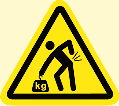
 |
| RP11 controller |
INTRODUCTION
In October 2016 I received an email from a guy named Hans.
- Dutch: Mijn schoonvader heeft nog een PDP 11/40 die weg moet inclusief alle randapparatuur. Hij
is nog op te starten ...
Bent U geïnteresseerd, anders wordt hij waarschijnlijk vernietigd.
Ik ben ooit 38 jaar geleden
op een 11/45 als operator gestart, dus dat laatste doet mij wel pijn ;-)
Translation: My father-in-law has a PDP-11/40 with peripheral devices that has to go. The system still starts ...
Are you interested, otherwise the machine will probably be scrapped.
Some 38 years ago, I started as an operator for an
11/45, so the latter does hurt me ;-)
You probably can guess my reaction! I promptly replied and told him that I would very much like to pick up everything, and that
nothing needs to be thrown away. As collector of these old machines I make sure that the system will have a great retirement home.
And Hans replied that his father-in-law and he would be very happy to see this computer go to a "good home", and that he will
link me to his sister in law who manages the site where the system is stored. And soon after, I received an email from Marica.
She wrote that I seemed to be very interested in the 11/40 and attached a few pictures. I almost fell of my chair!
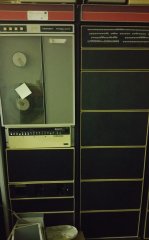
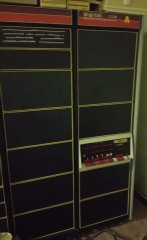
I saw a beautiful 3-rack PDP-11/40 system.
The rack at the right side is the 11/40 computer, the rack at the left side
contains a
Kennedy 9300 tape drive and a TU60 DECcassette. The rack in the middle has a 5.25 inch lights panel in the top and the rest of
the front to the bottom are filler panels. Later I found out that this rack is a complete RP11 controller and that "the peripheral
devices" are three RP03 disk drives, an LA120 terminal printer/console and a XXXX high-speed
lineprinter! Furthermore, a few terminals, modems, old PCs and PC printers.
The "catch" is that everything is stored in the cellar of a historical building. Between the cellar and the first floor are three
flights of stairs, one of 8 steps, one of 6 steps and one with 4 steps. Searching the web I found that one RP03 disk drive weighs
415 lbs, ~200 kilos! It is clear that I will need some helping hands!
On a Saturday I drove to Amersfoort to get an impression of
what is awaiting me. I tried to "lift" an RP03 at one corner, and concluded that the RP03 is indeed very heavy. I think
that planks on the stairs and then 3 guys pushing a drive on a blanket up the slope will get them out of the cellar. Same trick
will do for the high-speed line printer and the racks. All other stuff is just a lot of excercise going up and down the stairs,
carrying one item at a time.
Jumps within this page are the following:
|
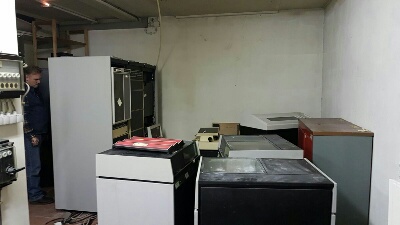 |
|
PDP-11/40 3-rack system, 3 RP03 drives, console printer and lineprinter |
THE MOVE OUT
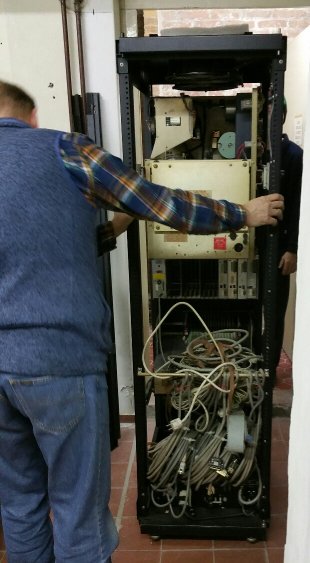
A truck with a hydraulic tailgate was rented for a Saturday. Together with Arjan (the friend of our daughter) we drove to Amersfoort.
After a cup of coffee, Arjan, Hans and myself went down the stairs into the cellar. While Arjan and Hans took "small" stuff upstairs,
I started to disconnect the drives and the cables between the racks. After a good hour we had the drives and the racks disconnected
(they were also bolted together with the metal filler strips), and agreed to try to push the "lightest" (better said: the
least heavy) rack upstairs first. I figured that pushing the rack up the stairs would be "a piece of cake" for 3 strong
guys ... Boy, was I wrong! It was easier said than done, but we managed to get the rack with the RP11 controller on the first floor.
The planks on the stairs were a good solution to push the rack up the stairs, but this approach only works well when the weight is
not too high ... It was clear that the rack with the Kennedy 9300 tape drive and the rack with the PDP-11/40 (with two H742
power supplies and two 21 inch BA11 chassis) could not follow in the same way.
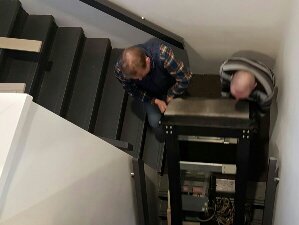
We removed the Kennedy tape drive from the rack and carried it up the stairs. The rack followed, and that was actually relatively
easy ... the rack lost some 70 kilos! From the last rack, I cut the tie-wraps of the power harness to the 11/40 chassis and
disconnected all plugs. Getting the 11/40 upstairs was not too difficult; the rack followed. But that did not go as easy as the
"emptied" rack of the tape drive. This rack still has two H742 (*heavy*) power supplies and one 21 inch BA11-L chassis with
several peripheral interfaces. But we got it up the stairs.
All that still had to be moved were "just" the three RP03 disk drives, the high-speed lineprinter and the LA120 console. The last
one was easy, but that could not be said of the other four "guys". The RP03 drives had been on their feet all those years, so the
casters and bearings are in great shape: on a smooth surface the drives roll easily. So, moving the first drive to he start of the
first stair was easy, and tilting the drive to rest the left side (most heavy side) on the planks was also easy. OK, three guys
behind the drive ... let's push it up the stairs. "Are we pushing?" Yes, but the drive did not even move a millimeter!
It is obvious we will not be able to get the drives out of the cellar this way. And the same goes for the lineprinter. Just way
too heavy!
So, sliding up the stairs might be a good idea, but it only works when the weight is not too heavy!
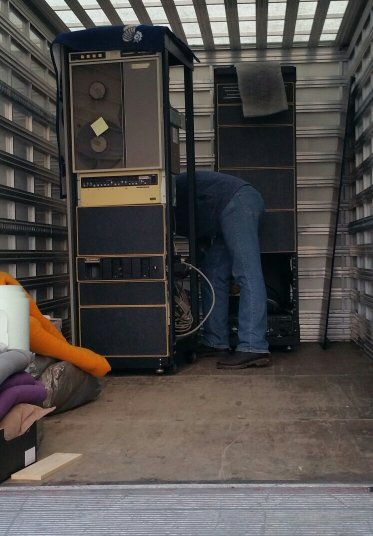
The system had been lifted into the cellar in the 1980ties through a hatch in the ceiling of the cellar. The hatch is at some
2,5 meters from the floor, so initially I did not consider it to be a "move out" option, especially because I was told that at
the other side the hatch was closed by a welded 10 mm steel plate.
Perhaps it is a good idea to have a closer look at the hatch in the ceiling of the cellar. Marica told us that the other side of
the hatch is in the garage, but is closed with a welded metal plate. As the stairs would not be an option to get the drives and
lineprinter out of the cellar, we went to the garage to have a closer look at that metal plate. It turns out that the metal plate
is not welded, it just lies there ... but a steel plate of 130 x 160 cm and 1 cm thickness is not going away easily. The opening
of that hatch is large enough to get the drive out. Above the hatch, on the ceiling in the garage is a lifting eye that was used to
get bags with potato starch into the celler long ago. But even 4 bags would be light compared to one RP03 drive. So, it remained
to be seen whether that lifting eye and its construction will be strong enough to hold, say, 250 kilos.
By now it was 16:00 and we decided to leave the drives behind (as if there was another option!), to call it a day and schedule a
new appointment. Oh, the high-speed lineprinter (of DEC, I still don't know the type designation but it was connected to the 11/40)
was also too heavy to get up the stairs, so that will also move out next time!
Driving home went smooth, and unloading the truck was done less than 20 minutes. Great that all this heavy stuff
is on wheels. That's why I always rent a truck with a hydraulic tailgate.
At 20:00 hours I was back home, the three racks and all smaller stuff unloaded in the "museum" ... the muscles
in my legs, back and shoulders clearly told me that I had moved something heavy that day (or am I just getting too old?) ...
The picture shows the rack with the Kennedy 9300 tape drive and TU60 DECcassette and the rack with the RP11 controller already
loaded into the truck.
SYSTEM HISTORY
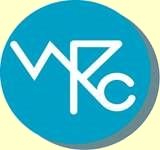
Marica's father purchased this system in the 1980ties for several tasks. Inventory, stock, purchases, personnel administration,
etc. Just all the usage you would expect a company would have for a big computer for in the "eighties". In the evening, the system
was sort of idling, and processor time and storage capacity was hired out to a nearby hospital.
The system was decommissioned at the end of the 1990ties, after serving the company for more than 15 years.
The history of the company (W. Ruitenberg Czn N.V.) goes back to the beginning of the 20th century (1904) when Marica's grandfather
founded the company. He traded in potato starch. And now, more than a century later, the fourth generation is at the helm of this
company. They are still active in the food industry and are a very successfull innovative company with almost 100 employees.
SYSTEM DESCRIPTION
The cellar of a historical building was the location of this computer system. The configuration is as follows.
- H960 rack #1 (at the right side) - PDP-11/40 processor, expansion box (both in a BA11-F 21" box) and two H742 PSUs (!)
- H960 rack #2 (in the middle) - RP11 disk controller
- H960 rack #3 (at the left side) - Kennedy 9300 tape drive, TU60 DECcassette, and a comms line concentrator (?) box
- LA120 - terminal/printer console
- ????? - high-speed lineprinter
- RP03 - 40 MB disk drive. Three of them, "pretty maids all in a row" (Eagles - "One of these nights").
RP11 CONTROLLER
The RP11 controller is housed in its own H960 cabinet and it fills the upper half of the rack. At the top is a 5.25" high lamp
indicator panel to show the various data and information. Below the indicator panel is a 5.25" blank filler panel and behind it
is nothing.

Below the blank filler panel are two 10.5" panels; behind them are four 5.25" high wire-wrapped units. The wire-wrap pin
bed faces the panels. From the rear side of the rack you can see the four units, fully populated with FlipChips. The cabinet
weighs 325 lbs. The input current is 7 Amps at 115 VAC, or 6 Amps at 230 VAC (3-phase).
RP03 DISK DRIVE
| Size | height: 40" width: 30" depth: 24" |
| Weight | 415 lbs (!) |
| Power | starting current: 30 Amps at 230 VAC, 60 Hz (3-phase)
running current: 6 Amps at 230 VAC, 60 Hz (3-phase) |
| Heat dissipation | 1300 W |
The RP03 disk drive is a beast in all aspects.
- It is big.
- It is heavy.
- And it is power hungry.
RP03 disk pack
The disk pack has 10 platters of which the outer ones serve as protection. Each disk pack can hold 20.480.000 (16-bit) words,
thus 40 MB.











